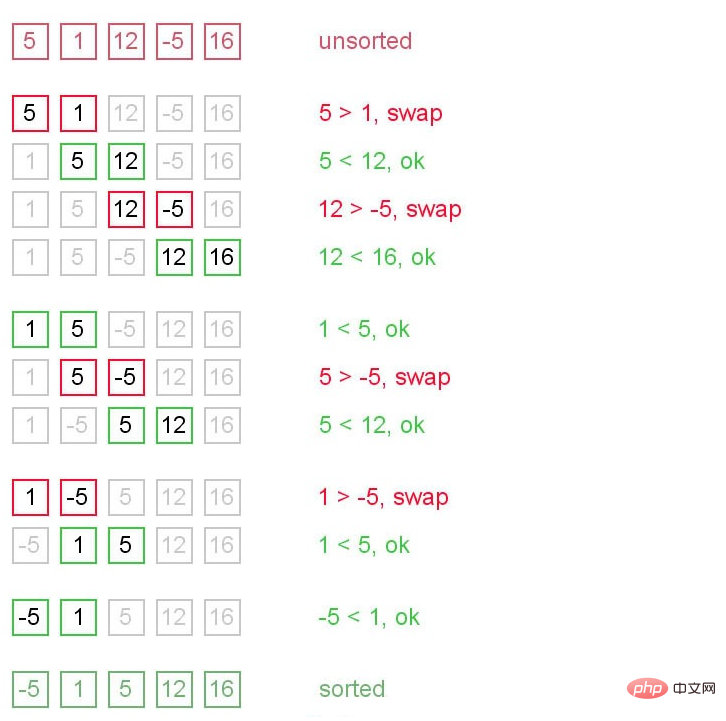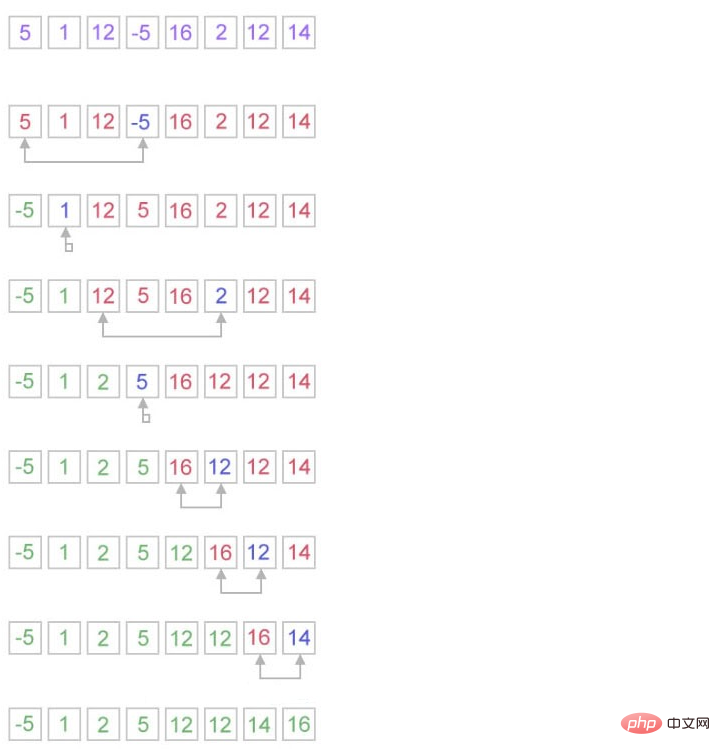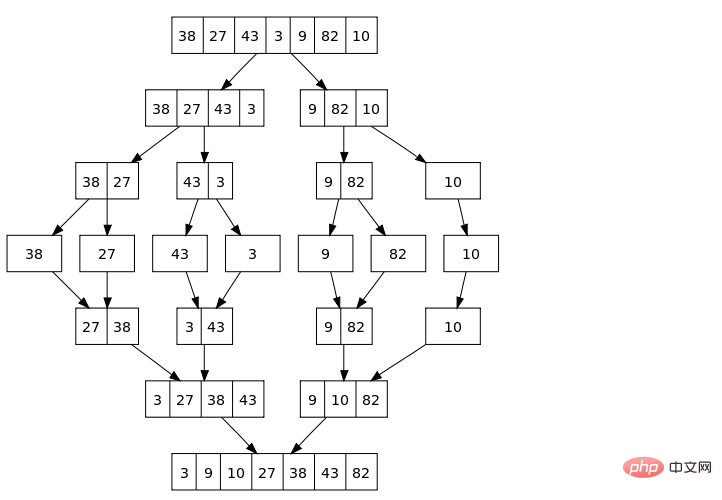Home >Java >javaTutorial >What are the sequential sorting methods?
What are the sequential sorting methods?
- angryTomOriginal
- 2019-07-23 14:54:1912698browse

Recommended tutorial: java tutorial
In computer science and mathematics, a Sorting algorithm (English: Sorting algorithm) is an algorithm that can arrange a series of data according to a specific sorting method. This article will summarize several commonly used sorting algorithms, including bubble sort, selection sort, insertion sort, quick sort and merge sort.
1. Bubble sort
Principle diagram

Understanding: By repeatedly iterating through the list to be sorted, comparing each pair of adjacent items, and swapping them if they are in the wrong order.
Code:
public class BubbleSort {
// logic to sort the elements
public static void bubble_srt(int array[]) { int n = array.length; int k; for (int m = n; m >= 0; m--) { for (int i = 0; i < n - 1; i++) {
k = i + 1; if (array[i] > array[k]) {
swapNumbers(i, k, array);
}
}
printNumbers(array);
}
}
private static void swapNumbers(int i, int j, int[] array) {
int temp;
temp = array[i]; array[i] = array[j]; array[j] = temp;
}
private static void printNumbers(int[] input) {
for (int i = 0; i < input.length; i++) {
System.out.print(input[i] + ", ");
}
System.out.println("\n");
}
public static void main(String[] args) { int[] input = { 4, 2, 9, 6, 23, 12, 34, 0, 1 };
bubble_srt(input);
}
}2. Selection sort
Principle Figure

Understanding: The inner loop finds the next minimum (or maximum) value, and the outer loop puts the value into its proper location.
Code:
public class SelectionSort {
public static int[] doSelectionSort(int[] arr){
for (int i = 0; i < arr.length - 1; i++)
{ int index = i; for (int j = i + 1; j < arr.length; j++) if (arr[j] < arr[index])
index = j;
int smallerNumber = arr[index];
arr[index] = arr[i];
arr[i] = smallerNumber;
} return arr;
}
public static void main(String a[]){
int[] arr1 = {10,34,2,56,7,67,88,42}; int[] arr2 = doSelectionSort(arr1); for(int i:arr2){
System.out.print(i);
System.out.print(", ");
}
}
}3. Insertion sort
Principle Figure

Understanding: Each step inserts a record to be sorted into the previously sorted sequence. Until all elements are inserted.
Code:
public class InsertionSort {
public static void main(String a[]){ int[] arr1 = {10,34,2,56,7,67,88,42}; int[] arr2 = doInsertionSort(arr1); for(int i:arr2){
System.out.print(i);
System.out.print(", ");
}
}
public static int[] doInsertionSort(int[] input){
int temp; for (int i = 1; i < input.length; i++) { for(int j = i ; j > 0 ; j--){ if(input[j] < input[j-1]){
temp = input[j]; input[j] = input[j-1]; input[j-1] = temp;
}
}
} return input;
}
}4. Quick sort
Schematic diagram

Understanding: Decompose the original problem into several smaller sub-problems but similar structures to the original problem, and solve these sub-problems recursively. problem, and then combine the solutions to these sub-problems into a solution to the original problem.
Code:
public class QuickSort {
private int array[]; private int length;
public void sort(int[] inputArr) {
if (inputArr == null || inputArr.length == 0) { return;
} this.array = inputArr;
length = inputArr.length;
quickSort(0, length - 1);
}
private void quickSort(int lowerIndex, int higherIndex) {
int i = lowerIndex; int j = higherIndex; // calculate pivot number, I am taking pivot as middle index number
int pivot = array[lowerIndex+(higherIndex-lowerIndex)/2]; // Divide into two arrays
while (i <= j) { /**
* In each iteration, we will identify a number from left side which
* is greater then the pivot value, and also we will identify a number
* from right side which is less then the pivot value. Once the search
* is done, then we exchange both numbers.
*/
while (array[i] < pivot) {
i++;
} while (array[j] > pivot) {
j--;
} if (i <= j) {
exchangeNumbers(i, j); //move index to next position on both sides
i++;
j--;
}
} // call quickSort() method recursively
if (lowerIndex < j)
quickSort(lowerIndex, j); if (i < higherIndex)
quickSort(i, higherIndex);
}
private void exchangeNumbers(int i, int j) { int temp = array[i]; array[i] = array[j]; array[j] = temp;
}
public static void main(String a[]){
MyQuickSort sorter = new MyQuickSort(); int[] input = {24,2,45,20,56,75,2,56,99,53,12};
sorter.sort(input); for(int i:input){
System.out.print(i);
System.out.print(" ");
}
}
}5. Merge sort
Principle Figure

Understanding:Divide the sequence to be sorted into several sub-sequences with a length of 1, and then divide these sequences into two Merge two; obtain several ordered sequence of length 2, and then merge these sequence two by two; obtain several ordered sequence of length 4, and then merge them two by two; until directly merged into one sequence.
Code:
public class MergeSort {
private int[] array; private int[] tempMergArr; private int length;
public static void main(String a[]){
int[] inputArr = {45,23,11,89,77,98,4,28,65,43};
MyMergeSort mms = new MyMergeSort();
mms.sort(inputArr); for(int i:inputArr){
System.out.print(i);
System.out.print(" ");
}
}
public void sort(int inputArr[]) { this.array = inputArr; this.length = inputArr.length; this.tempMergArr = new int[length];
doMergeSort(0, length - 1);
}
private void doMergeSort(int lowerIndex, int higherIndex) {
if (lowerIndex < higherIndex) { int middle = lowerIndex + (higherIndex - lowerIndex) / 2; // Below step sorts the left side of the array
doMergeSort(lowerIndex, middle); // Below step sorts the right side of the array
doMergeSort(middle + 1, higherIndex); // Now merge both sides
mergeParts(lowerIndex, middle, higherIndex);
}
}
private void mergeParts(int lowerIndex, int middle, int higherIndex) {
for (int i = lowerIndex; i <= higherIndex; i++) {
tempMergArr[i] = array[i];
} int i = lowerIndex; int j = middle + 1; int k = lowerIndex; while (i <= middle && j <= higherIndex) { if (tempMergArr[i] <= tempMergArr[j]) { array[k] = tempMergArr[i];
i++;
} else { array[k] = tempMergArr[j];
j++;
}
k++;
} while (i <= middle) { array[k] = tempMergArr[i];
k++;
i++;
}
}
}The above is the detailed content of What are the sequential sorting methods?. For more information, please follow other related articles on the PHP Chinese website!

